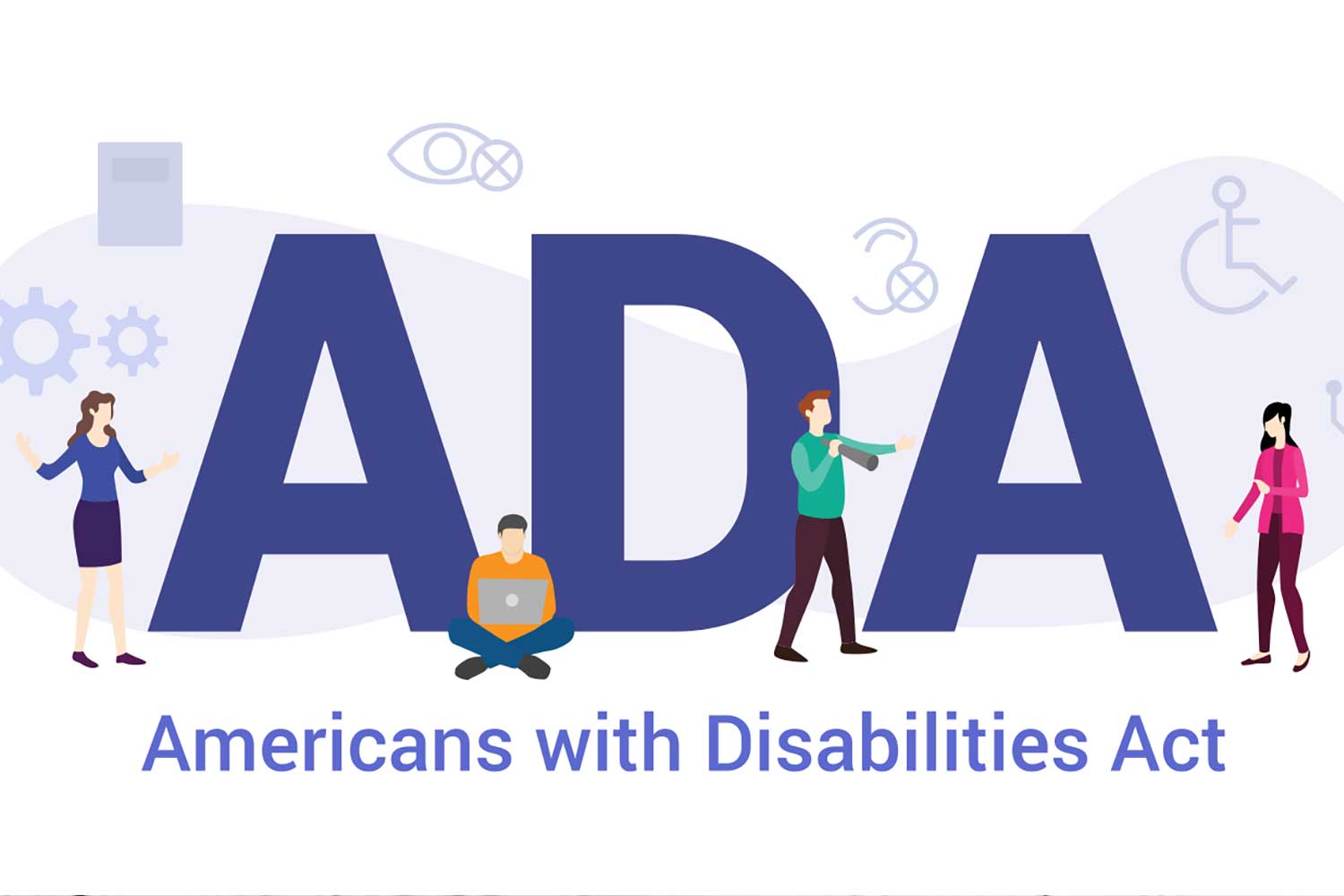If you want to overwhelm a nonprofit manager, tell them an employee has requested an accommodation for a disability, and ask them to find out the organization’s obligations. When managers face trying to navigate a confusing web of laws, a common result is to just reject the employee’s request. Nonprofits may have the best of intentions when drafting enthusiastic and inclusive policies, but these goals are abandoned when managers become overwhelmed by the process or fear of lawsuit.
By breaking down the terminology used in federal workplace disability law, we hope to encourage nonprofits to navigate these issues with more confidence. This not only creates a more inclusive workplace, it increases retention and productivity, as well as broadening the pool of employees that your nonprofit hires from.
When the Americans with Disabilities Act (ADA) was passed in 1990, it was considered a sweeping civil rights law, with implications for the workplace as well as public accommodation, public services, communications and transportation.
Following a series of decisions by the U.S. Supreme Court which narrowed the definition of “disability,” the ADA was amended and updated to reflect a more contemporary view of inclusion. Following the 2008 amendments, it became significantly easier to qualify as an individual with a disability under the Act.
One of the main goals of the ADA was intended to remove traditional barriers to employment for individuals with disabilities.[1] The ADA requires covered employers to provide reasonable accommodation to employees or applicants with disabilities, unless doing so would cause an undue hardship.[2]
The Equal Employment Opportunity Commission (EEOC) is charged with enforcing the ADA in employment, and issues regulations and guidance to assist in interpreting the specifics of the law. Many states also have laws that parallel the provisions of the ADA.
Nonprofits should know whether state anti-discrimination laws also apply to their organization. In California, for example, these laws apply to employers of five or more, and define a disability as an impairment (note the absence of the word “substantial” as compared to the federal law).
In addition, differences between how the thirteen federal circuit courts interpret the ADA means, unless the U.S. Supreme Court has stepped in with a definitive decision, disability discrimination law can vary considerably across the U.S.
Terminology in the Americans with Disabilities Act (ADA)
Understanding the workplace implications of the ADA means understanding the terminology. The basic rule is: covered employers are obligated to engage in the interactive process with qualified applicants or employees to provide reasonable accommodations that will allow them to perform the essential functions of their job, unless such an accommodation would cause an undue hardship to the employer. [3]
Whew! That’s a lot. No wonder it can feel overwhelming. Now let’s briefly look at each of these terms and break them down into practical steps.
Disabled Individual
Contrary to popular belief, the ADA does not identify a list of medical conditions that would render someone disabled under the law. A disabled individual is defined as one of the following:
- Someone with a physical or mental impairment that substantially limits one of more major life activities
- A person who had a history or a record of such an impairment
- A person who is perceived by others as having such an impairment
As emphasized in the 2008 amendments, it is the nature of the impairment—that is, the effect on the individual’s ability to engage in certain activities—that will determine whether they are “disabled” under the law. Chasing down whether an individual is truly “disabled” is rarely productive—it’s better to focus on the requested accommodation instead. That said, the law does allow the employer to require medical certification of the disability and work limitations if the employer chooses.
Essential Functions
Essential functions are those core duties of the job that, if eliminated, would change the fundamental nature of the job. Having a function listed on a job description will not be sufficient proof that the duty is “essential.” Qualifications that are preferable for the job are also not “essential.”
The issue of what defines “essential functions” has been the subject of a great deal of litigation. In 2018, a Texas-based employer learned a $2.6M lesson in ADA compliance when it was sued by the EEOC for violating the ADA. The company provided food demonstrators to grocery stores and had a strict policy that its employees could take no more than a 10 minute “sitting break” every two hours. Otherwise they had to stand as they were working. The company refused to make exceptions to this rule for individuals whose medical conditions meant they couldn’t stand for two hours at a time. According to the employer, standing is an essential function of the job. The court found that standing for 110 minutes out of 120 was not an “essential function” of a food demonstrator. The store settled with the EEOC before a verdict in the lawsuit. [4]
Interactive Process
An individual’s request for an accommodation triggers the employer’s obligation to engage what is referred to as interactive process. Although interactive process is intended to be an “informal dialogue” between the employer and employee, most employers do document this process carefully to protect themselves. Employers need to understand two critical things about the interactive process. The first is that there are no “magic words” that trigger an obligation to begin this process. The employee doesn’t have to use the word “accommodation.” The ADA therefore puts the burden on the employer to recognize when an employee is requesting a change to their work schedule, duties or environment that stem from their own disability (as opposed to a request that is simply for their own convenience). Clarify whether it’s necessary to start the interactive process simply by asking the employee, “Is there anything you need?”
The second critical point is that the interactive process not optional. Even if an employee cannot show that the employer failed to provide a reasonable accommodation, not going through the interactive process is its own cause of action. In other words, an employer can be liable for violating the ADA by refusing to engage in the interactive process.[5]
In one case involving the production line of an auto manufacturing plant, a manager denied an employee’s request for a part-time schedule. The employee had made clear the request was due to their own medical condition. The manager did not initiate the interactive process, but just told the employee that part-time work was “not an option.” The court found this outright rejection of the request was a failure to engage in the interactive process.[6]
The employer wouldn’t necessarily have been obligated to provide the schedule, but they are obligated to engage with the employee to try to find a solution that would keep the employee working. Employers run afoul of the interactive process when they reject an employee’s request for accommodation out of hand, without considering the wider context—including whether other accommodations, such as transfer to another job, might be effective. The key point of the interactive process is to find an accommodation that will allow the employee to remain employed. Even if the employer doesn’t think they can provide the accommodation requested by the employee, they must go through the interactive process to determine the nature of the employee’s limitations and explore alternative accommodations.
Reasonable Accommodation
A reasonable accommodation is any change that will allow an employee to perform the essential functions of their job. It might be a schedule change, it might be a modification of nonessential duties, a leave of absence, the ability to bring a service dog to work, remote work, special equipment or services.
If there are multiple accommodations that will allow the employee to perform the essential functions of the job, the employer may choose the one that is the easiest to implement, even if it is not the employee’s preferred accommodation.[7] As long as the accommodation provided enables the employee to perform the essential functions of the job, it will be considered satisfactory.
In a lawsuit, once the plaintiff has shown that the accommodation they need is reasonable, the employer will have the burden of proving that the accommodation would have created an undue hardship.[8] This puts strong pressure on the employer to make the accommodation if at all possible, and if they truly cannot, to carefully document why.
Undue Hardship
Logically, if the accommodation for an employee is described using the word “reasonable,” then the standard refusing such an accommodation would be anything that is “unreasonable.” Not so. Undue hardship is a much higher standard, one that looks not just at the employee’s role but at the entire organization. The EEOC defines an undue hardship as “an action requiring significant difficulty or expense.”[9] What is considered a significant difficulty or expense is considered in light of the overall resources of the employer. Every situation will be different. Critically, making an exception to an employer’s policy does not, by itself, create an undue hardship. Similarly, an employer’s concern that other employees will regard the accommodation as unfair, or that other employees may want a similar accommodation, is also not an undue hardship.
Common Issues When Implementing Reasonable Accommodations
Just as important as understanding what an employer is obligated to do is understanding what they are not obligated to do.
A reasonable accommodation does not require employers to accommodate lower productivity. If a therapist is required to have a patient caseload of 20 patients, and the employee requests a smaller caseload, the employer need not lower that standard. But the employer should explore alternatives, for example, a part-time schedule, offloading of nonessential duties, or transfer to another job.
Nothing in the ADA requires employers to tolerate the use of illegal drugs in the workplace. While alcoholism (but not drug addiction) is recognized as a disability, an appropriate accommodation would be time off to allow for treatment.
While it may be appropriate to have ancillary services to support the work of an employee, it would not be a reasonable accommodation to create a position whose function is solely to assist the disabled employee. An unpaid leave of absence is an appropriate accommodation, even if the employee would not be entitled to medical leave under the employer’s policies.[10] The right to leave, however, is not unlimited.
Case law on the ADA has consistently found that employers are not required to provide leaves of absence for an indefinite period (including repeated requests for extensions). Employers must be able to show that the employee was clearly warned their employment is at risk if they could not return from leave, and to clearly articulate why the position cannot be held open for the requested leave period.
While schedule modifications are very common types of accommodations, one that would prevent other employees from doing their jobs is an undue hardship. Let’s examine two circumstances to see how that might work:
- An employee with a mental health condition takes a medication that makes them groggy in the morning. The employee requests a regular work schedule of 10 a.m. to 7 p.m. The other employees in the nonprofit work 8 a.m. to 5 p.m., and the regular staff meeting is held at 9 a.m. The employee’s colleagues or manager may sometimes find it inconvenient that they have a different schedule, but it doesn’t prevent them from doing their jobs. There’s nothing about having the meeting at 11 a.m. instead of 9 a.m. that creates an undue hardship for the employer.
- In a different setting, this change might not be practical. If an employee cannot come into work until 10 a.m., and they are a teacher in a preschool that runs from 8 a.m. to noon, then they are likely not qualified for the job. Compare that situation to a preschool that offers both morning and afternoon sessions, where moving the employee to an afternoon classroom would be an appropriate accommodation.
The ADA is a mechanism for removing barriers to employment, not a trap for well-intentioned employers. The situations that end up in court are those that are highly complex or were truly bungled or ignored by the employer. It’s easy to lose sight of how straightforward making accommodations can often be.
Nonprofit managers make accommodations all the time, often without realizing it. Take a situation where an employee asks to adjust their schedule one day a week, so that they can go to their regular physical therapy appointment.
The employee’s supervisor agrees and asks the employee if they can avoid scheduling the appointment on Thursday afternoon, when the weekly meeting with the state funding agency is held. That change represents an accommodation for the employee. There’s no complex process, no documentation needed, no extended negotiation, yet you can see each of the definitions and steps in this interaction. It’s a simple change that allows an employee to continue working.
The discussion about disabilities at the workplace so often focuses on the liability that it’s easy to lose sight of how common these accommodations really are. But accurate and understandable information about the employer’s obligations results in a more productive and accessible workplace.
Removing the hurdles an individual with a disability may face in the workplace represents meaningful accessibility, one that allows both the employer and the employee to focus on their work rather than their limitations.
References
[1] Employment is only one aspect of the ADA. The ADA also promotes equal opportunity for individuals with disabilities in the areas of public accommodations, transportation, state and local government and telecommunications.
[2] Title I ADA generally covers employers with 15 or more employees, including state and local governments, employment agencies and labor unions. There is no exception for nonprofits. Some states have separate disability discrimination laws with a lower employee threshold. Consult an attorney if you are unsure whether your nonprofit is covered by the disability discrimination laws.
[3] Although the word “employee” is used throughout this article, the ADA applies to both applicants and employees.
[4] EEOC Press Release November 21, 2019 (https://www.eeoc.gov/newsroom/crossmark-pay-265-million-settle-disability-lawsuit)
[5] U.S. Airways, Inc. v Barnett, 535 U.S. 122 S. Ct. 1516, 1523 (2002)
[6] Fisher v. Nissan North America, Inc., 951 F.3d 409 (6th Cir. 2020)
[7] See Appendix to 29 C.F.R. 1630.9
[8] U.S. Airways, Inc. v Barnett, 535 U.S. 122 S. Ct. 1516, 1523 (2002)
[9] See 42 U.S.C. § 12111(10) (1994); 29 C.F.R. § 1630.2(p) (1997); 29 C.F.R. pt. 1630 app. § 1630.2(p) (1997)
[10] The EEOC has taken the position that “no fault” attendance and leave policies are inconsistent with the ADA. These policies result in discipline or dismissal when a certain absence threshold is reached regardless of the reason the employee was not at work. All attendance and medical leave policies should have a written exception for individuals with disabilities.





